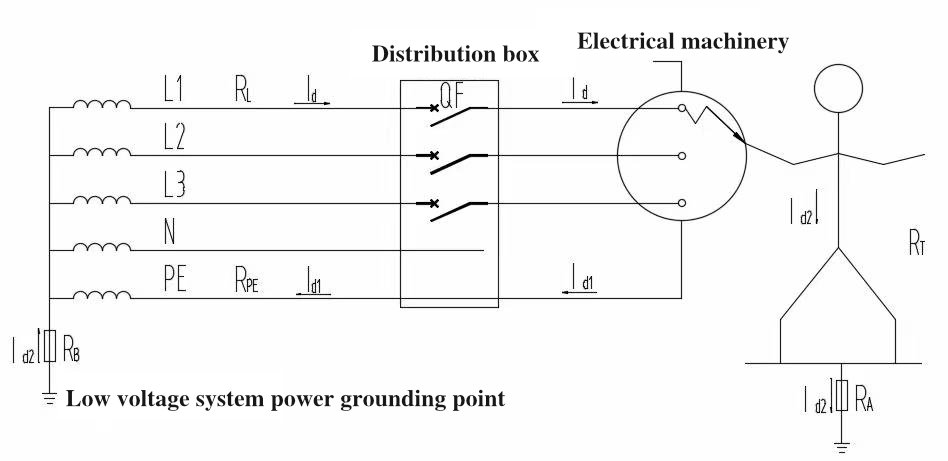
Simplified Motor Protection Relay Wiring Diagram
Abstract: This article will focus on the motor protection

Abstract: As you know motor short circuit protection is very important for motor protection. This article will introduce the causes, definition, and solutions for motor short circuit protection.
A short circuit is an overcurrent phenomenon that occurs after insulation is destroyed, and short circuit protection is a protection set up to avoid the danger of such overcurrent. In motor protection, a short circuit refers to the connection between two or more electrical conductors in the circuit. An abnormally low impedance occurs during the period. This abnormally low impedance may cause excessive current, causing damage or even danger to circuits and equipment. Motor short circuit protection is designed to monitor and detect this abnormal situation and take timely measures to prevent the equipment or the system is seriously damaged.
Motor short circuits are generally divided into line-to-line short circuits, phase-to-phase short circuits, and short circuits to the ground.
Line-to-line short circuit: This type of short circuit occurs between different conductors in the same circuit, causing current to bypass the normal circuit path and flow through an abnormally low impedance path. Short circuits between lines can be caused by damaged insulation, direct contact between conductors, or external factors.
Phase-to-phase short circuit: This type of short circuit occurs between different phases of the motor, such as between phase A, phase B, or phase C in a three-phase AC circuit. Phase-to-phase short circuits may be caused by internal faults in the motor windings, damaged insulation, or external faults.
Ground Short Circuit: A ground short circuit refers to a short-circuit connection between the winding or shell of the motor and the ground. Ground short circuits may be caused by insulation damage, intrusion of external substances, aging of equipment, etc. A ground short circuit will cause the insulation performance of the motor to decrease, increase the risk of leakage and electric shock, and may also affect the normal operation of the motor.
To prevent harm caused by short circuits, motor protection systems usually adopt various protection devices and control strategies, such as overload protection, short circuit protection, grounding protection, etc. These motor protection devices can promptly detect abnormal conditions in the circuit and take automatic or manual measures, such as cutting off power or sounding an alarm, to reduce equipment damage and personnel safety risks.
Motor short circuits can be divided into internal factors and external factors. Here are some common causes of a short circuit in a motor:
Insulation aging or damage: The insulation system of motors may be aged or damaged if it is used for a long time or is affected by the external environment (such as moisture, chemicals, etc.). Aging or damage to the insulation will lead to a decline in insulation performance and prone to insulation short circuits, causing a low-impedance path to be formed between the conductors inside the motor.
Winding failure: The winding inside the motor is a key part of the current flow. If the winding fails (such as a winding short circuit, phase-to-phase short circuit, etc.), it will cause the overall motor short circuit. Winding failures can be caused by issues such as incorrect winding wiring, damaged insulation, cable joint problems, and so on.
External factors: External factors are also one of the common causes of motor short circuits. For example, damaged cables, water or chemicals entering the motor, circuit overload, equipment failure, etc. may cause motor short circuits.
Operation errors: During operation, if the operation is improper or the maintenance is not in place, it may also cause a motor short circuit problem. For example, overload operation, frequent starts, and stops, neglect of maintenance, etc. may cause motor short circuits.
Design defects: In some cases, there may be defects in the design of the motor, such as an unreasonable winding layout, improper selection of insulation materials, etc. These design defects may increase the risk of motor short circuits.
Short circuit protection of motor refers to the use of specific motor protection devices and measures to prevent short-circuit faults in the motor and minimize damage caused by short-circuits. When a short-circuit fault occurs in the motor, the motor short circuit protector will act quickly to cut off the power supply to prevent the motor from burning out. Motor short circuit protection is designed to ensure the safe operation of motors and related equipment while improving system reliability and stability.
The common motor short circuit protection components are fuses, circuit breakers, and motor protection relays.
Fuses: Fuses are a common device used to protect circuits and equipment from overloads and short circuits. When the current in the circuit exceeds the fuse rating, the fuse will blow, cutting off the circuit and preventing excessive current from passing through, thereby protecting the motor.
Circuit Breakers: A circuit breaker is a device used to protect motor electrical circuits from overloads, short circuits, and other faults. The circuit breaker can detect abnormal currents in the circuit and quickly cut off the circuit when a fault occurs to prevent equipment damage or fire hazards caused by excessive current.
Protection Relays: A protection relay is a device used to monitor the status of an electrical system and respond to abnormal conditions. For motor short circuit protection, motor protective relays can monitor parameters such as current, voltage, temperature, etc., and trigger protective actions, such as cutting off the power supply or sounding an alarm, when a short circuit or other fault is detected.
Overload Protection Devices: Overload protection devices are used to monitor the current when the motor is running. When the current exceeds the set rating, the protection device will be triggered to prevent the equipment from being damaged due to overload.
Ground Fault Protection Devices: Ground fault protection devices are used to monitor ground faults in circuits, such as ground short circuits. When a ground fault is detected, the ground protection device cuts off the circuit to protect equipment and personnel.
Insulation Monitoring Devices: Insulation monitoring devices are used to monitor the insulation status of electrical systems. When insulation degradation or insulation faults are found, an alarm will be issued or measures will be taken to prevent problems such as motor short circuits.
Blue Jay’s Motor Protector is a reliable protection relay designed to protect electric motors from faults such as motor short circuits.
The Blue Jay motor protector has a powerful short-circuit protection function that can immediately perform protection when a short circuit occurs due to incorrect motor wiring or damaged wiring. It works by monitoring changes in current in a circuit to identify short circuit conditions. When the system detects a short circuit, the protector will quickly enter protection mode to prevent excessive current from causing damage to the motor. Besides, our motor protection relay integrates many functions such as overload protection, overcurrent protection, ground fault protection, and so on.
Motor Short circuit protection parameter setting
Protection action | OFF/Alarm/Trip DO |
Threshold | 100-1000%le |
Trip delay | 0.1-50.0s |
This motor short circuit protection function is automatically enabled when the device is running and is suitable for setting high current action values to ensure quick response to potentially dangerous short circuit situations. The delay time setting should be short and set to the same value as the breaking current under the system settings. In this way, when a fault occurs, the protector can trip the circuit breaker first and then the contactor, effectively isolating the fault and protecting the motor and system.
Blue Jay motor protection device is suitable for a wide variety of industrial and commercial applications, including but not limited to:
For different application needs, Blue Jay provides a variety of customization options, including rated current range, delay time settings, and alarm functions. These options can be adjusted to specific system requirements to ensure optimal protection performance and system compatibility.
Competitive Factory Price and High Value
We have two factories so we can provide you affordable and cost-effective. Considering its robust short-circuit protection, reliability, and customization options, investing in our motor protection device is a wise choice for motor safety. It can not only help reduce equipment repair and replacement costs but also improve production efficiency and system stability, bringing long-term value and returns to the enterprise.
All in all, Blue Jay Motor Protector is recommended as a critical step in ensuring the safe operation of your motor. Its short-circuit protection capabilities, wide application range, customization options, and reasonable price make it a trustworthy protection device in industrial and commercial fields.

Abstract: This article will focus on the motor protection

Abstract: This article will introduce the under voltage protection

The Motor ground fault protection is to provide protection




